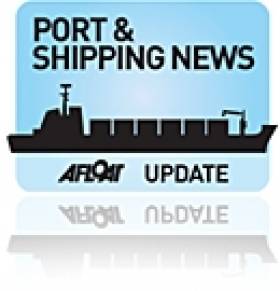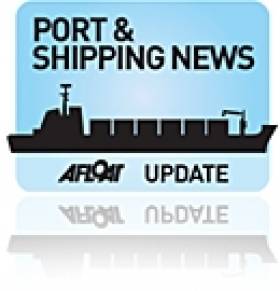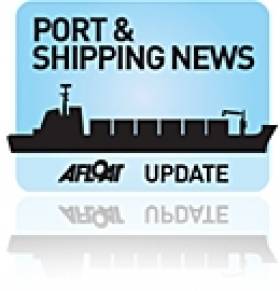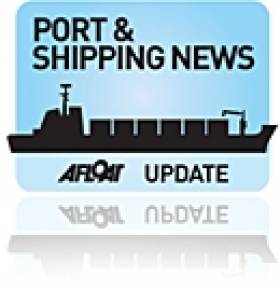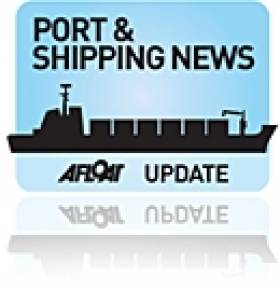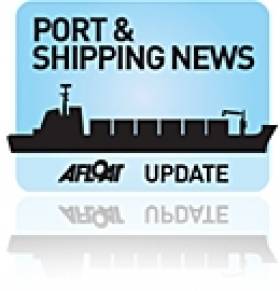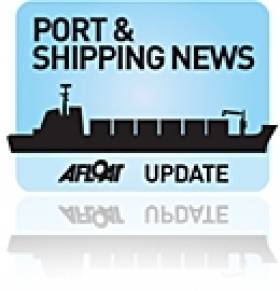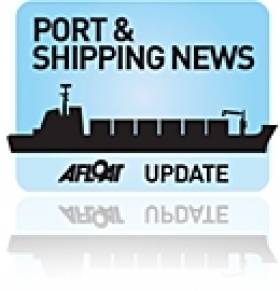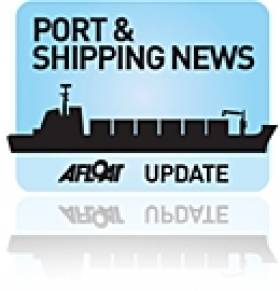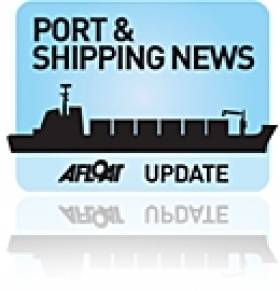Displaying items by tag: Port and Shipping News
World's Biggest Capacity Container Ship In First UK Visit
#Shipping - The world's biggest capacity container ship is currently docked in Felixstowe in its first ever visit to UK waters, as BBC News reports.
The MSC Oscar is somewhat shorter than the CSCL Globe which called at the same port in January, as previously reported on Afloat.ie – though it still has a deck the size of four football pitches.
However, it's in the weightlifting department where the 393m Oscar – launched from the Daewoo shipyard in South Korea last year – has the Globe beat, with capacity for 124 more containers.
The MSC Oscar's visit comes just a week after the largest ship to ever sail up the Thames visited the new DP World London Gateway just west of Canvey Island in Essex.
Grounded Cargo Ship Moved To Safer Anchorage
#Shipping - Stricken cargo ship the Lysblink Seaways was set to be moved to a safe haven yesterday afternoon (25 February) in advance of poor weather.
As previously reported on Afloat.ie, the 120m-long vessel ran around near Ardnamuchan Point in Scotland's West Highlands a week ago while en route from Belfast to Norway.
The ship later refloated in high tide a day after her hull was lifted onto the rocky shore near Kilchoan.
Divers began inspections for damage as the Lysblink Seaways dropped anchor near the grounding spot in Mingary Bay.
But according to Practical Boat Owner, severe weather forecast for the next few days prompted quick action to pump out more than 150 tonnes of fuel from the ship.
She was then scheduled to be towed to a safe anchorage at Scallastle Bay in the Sound of Mull, some 17 miles away.
Practical Boat Owner has more on the story HERE.
Cargo Ship Stuck On Rocks In Scotland's West Highlands
#Shipping - A cargo ship en route from Belfast to Norway has run aground near Ardnamurchan Point in Scotland's West Highlands.
And as BBC News reports, the UK coastguard believes it will be stuck there for some time.
The Lysblink Seaways, a 120m-long vessel, found its hull lifted onto the rocky shore after getting into difficulty off Kilchoan in the early hours of yesterday morning (18 Feburary).
There are no reports of injuries among the nine crew on board, and tugs are on the way to try to dislodge the hull from its perch.
BBC News has images of the stricken ship HERE.
Shipping Review: Maiden Call, Boxship Returns, Runcorn Records, ESPO On T-TEN & More
#Ports&ShippingReview - Over the last fortnight, Jehan Ashmore has reported on the shipping scene, where Arklow Beacon, the fourth of six Arklow Shipping newbuilds made her maiden call to Dublin Port.
Atlantic Companion, the massive containership bound for Canada that lost engine power in Irish waters that led to repairs in Bantry Bay, instead returned to Liverpool, her last port of call.
On a related note, next month's Merseyside Maritime Awards "overwhelmed" with the number of entries.
Downriver and leading off is the Manchester Ship Canal where the port of Runcorn Docks smashed monthly cargo records and doubled freight over past 12 months.
Another 'Arklow' cargoship, Arklow Viking called to Runcorn last November and last week she docked in a Portugal, for more click 'CargoShipFocus'.
A European Sea Ports Organisation (ESPO) seminar included core topics to include the new TEN-T Guidelines on transport infrastructure to be funded by the EU.
ESPO Hopes Junker Investment Plan Does Not Undermine New TEN-T Policy
#ESPOjunker - The European Sea Ports Organisation (ESPO) in late January held an internal seminar on infrastructure financing.
The seminar aimed to give ports some practical information on what to expect from European Investment Bank (EIB) lending and financial instruments.
Speakers came from the European Commission, European Investment Bank and the EU's Innovation and Networks Executive Agency (INEA). Presentations focused on the new European Fund for Strategic Investment (EFSI) that is being set up following a recent initiative by European Commission President Jean-Claude Juncker, as well as existing instruments such as classic EIB lending, the Loan Guarantee Instrument for Trans-European Transport Network Projects (LGTT) and project bonds.
Ports were particularly interested in the details of the Juncker Plan. The European Fund for Strategic Investment (EFSI) aims to leverage investments in the magnitude of €315bn by covering part of the risk of projects.
For this purpose, the EU plans to set up a guarantee fund. Of the €8bn that are to be taken out of the EU budget for the new guarantee fund, EUR 2.7bn are to come from the transport envelope of the Connecting Europe Facility (CEF), in particular from the general grant part of the CEF envelope.
This means that the overall sum available for grant funding of transport projects (in non-cohesion countries) is considerably cut by the Juncker plan. The existing envelopes for financial instruments and transport investments in cohesion countries remain untouched.
The TEN-T Guidelines defined a stringent methodology for the eligibility and priorities of transport infrastructure. During the past year, the Commission, member states and infrastructure managers have jointly worked on corridor work plans that are to identify the priority projects with the highest European added value that should thus be the first recipients of EU funding.
In this methodology, ports are seen as the entry and exit points to the European corridors and are thus the strategic starting point for defining the transport needs of Europe. However, under the EFSI, any European transport project independent of location and mode of transport can receive funding. This shifts the logic away from the carefully chosen transport priorities of the CEF and TEN-T
Moreover, the EFSI does not ring-fence money for any particular type of investments. Different sectors ranging from energy, to education and health will be competing for financing. The money transferred from the CEF could thus end up being absorbed by other sectors if these are better able to present mature projects with clear revenue streams.
ESPO Secretary General Isabelle Ryckbost said: "Ports have been given a strategic role in the new TEN-T policy. We are a little concerned about what we have learned today about the new European Fund for Strategic Investment. By shifting a part of the CEF grant money to the new financial instruments we are not only diminishing the possibility for ports of receiving a grant but there also seems to be a possible shift in priorities."
She added "The criteria used by the EIB to assess projects are very different from the priorities set by the new TEN-T policy, which recognises the important role of ports as core nodes of Europe's Transport Infrastructure and entry and exit points to the European corridors."
#Arklow'V'sisters – Runcorn's record freight in 2014 as previously reported on Afloat.ie, referred to a call to the dock port by Arklow Viking to load salt for Spain, it is understood she is currently in neighbouring Portugal, writes Jehan Ashmore.
Arklow Viking is one of a trio of Arklow Shipping 'V' class 4,950 total dwt cargoships managed by Dutch subsidiary, Arklow Shipping N.V.
Her Portuguese port of call is Ribdeo, having taken a passage through the Bay of Biscay that involved rounding Galicia on Spain's north-western coast from a departure in Lisbon.
Also today, Arklow Venture which had berthed along Cork's City south quays had also sailed from an Iberian port, Musel Arnao. This afternoon she departed the Port of Cork for the short-sea coastal passage off the Cork and Kerry peninsula's and is bound for Foynes on the Shannon Estuary.
While earlier this week on Tuesday, Arklow Venus arrived to Dublin Graving Docks Ltd. The 90m long vessel had made the short sea passage in ballast from Avonmouth Docks.
On arrival at the Irish port, she initially moored along the Lead-In East Jetty within Alexandra Basin before entering the dry dock. The marine engineering business carries out repairs, maintenance and overhauls.
It is understood Arklow Venus is to remain in the graving dock until early next month and follows last year's call of Arklow Viking, for her third special survey.
The 200m long dry-dock is the only such facility in the port. The graving dock chamber can cater for two ships simultaneously or one larger vessel.
As previously reported on Afloat.ie, DGD potentially faces closure as the Dublin Port Company plan to redevelop Alexandra Basin by re-using the dry-dock site to provide more quayside cargo space.
On a related note to space and that of cargo volumes, the ASL fleet carry cargoes varying from peat-moss to animal feed and fertiliser. The 'V' class sisters for examples can handle a hold grain-bale capacity of 198762 ft³/5628 m³.
The Dutch flagged trio were all built by Pattje Shipyard B.V., Netherlands, where the yard launched the 'Venus' in 2000, however her sisters both date to 1999.
This pair having been completed before the millennium stand-out, compared to the rest of the 44 cargoships (up to 34,905dwt) to date that were all were built since 2000.
The order for six 'B' class 8,660dwt newbuilds is nearing completion as the fifth in the series, Arklow Brave was launched in mid-December 2014. She was expected to be delivered to her owners this month.
Runcorn Dock Breaks Cargo Record and Doubles 2014 Freight Volumes
#RuncornRecord – Manchester Ship Canal port of Runcorn Docks has smashed its monthly cargo record and doubled its freight handled over the past 12 months, writes the Liverppol Echo.
The developments follow a multi-million pound investment by owner Peel Ports.
In December, the facility dealt with 50,126 tonnes of cargo – its highest-ever monthly total.
The cumulative weight of the record shipment of cargo is equivalent to more than 31,420 Range Rover Evoques, 122m tins of beans.
In addition to the port handling more than 66.8m boxes of Kellogg's Cornflakes carried on Coastal Deniz as featured in a TV documentary 'Ade to Sea' during a regular shuttle service to Liverpool Docks.
In the same month, Runcorn also handled its biggest ever single shipment of cargo in its history, with the arrival of vessel Kristin C, which discharged 6,212 tonnes of soda ash for its customer Newport Industries.
The ash will be used to manufacture glass. For more on this story, click HERE.
Afloat.ie adds that during the era of the last Guinness stout-tankers, they used to call to Runcorn Docks to discharge the black stuff for the UK market.
The Irish connection continues to the present day in the form of Arklow Shipping, whose distinctive green hull coloured general cargoships call, among them Arklow Viking.
According to Ships Monthly, the 1999 built vessel in November called to Runcorn Salt Works to load 4,000 tonnes of salt for Figueria de Foz in Portugal.
#ShipRepairs – Atlantic Companion, the massive containership that was in Irish waters bound for Canada, having undergone repairs in Bantry Bay last week, is instead returning today to Liverpool, her last port of call, writes Jehan Ashmore.
As previously reported on Afloat.ie, the 57,000 tonnes vessel this day last week, had lost engine power and drifted for almost 12 hours off the Cork coast.
Altantic Companion, a G3 generation class 'con-ro' vessel which can carry containers and vehicles, was en-route from Liverpool to Halifax, however, she developed problems with one of the six cylinders on its main engine, but was able to reach the shelter of Bantry Bay.
Following repair work, it was then expected according to the ships owners, Atlantic Container Line (ACL) that the 1984 built Swedish-flagged containership would last Thursday, resume its trans-Atlantic voyage to Halifax.
Afloat.ie adds that Atlantic Companion had actually departed Bantry Bay the following Sunday but it transpired she set a different course not to Canada but a reverse passage bound for Liverpool. This involved a routine transit by the ACL ship through the Vessel Traffic Separation Scheme (VTSS) of Wexford's south-east coast until she arrived off Anglesey last night and from where she anchored.
Also last night along this same stretch of the north-west Welsh coast, sisters, Atlantic Concert was heading for Liverpool while Atlantic Cartier was in the reverse direction bound for Halifax, Canada.
For more than 40 years, ACL has been a pioneering force and leader in the North Atlantic Trade operating liner services between European ports and the US East coast.
The 2,160 TEU containership, Atlantic Companion and her sisters, may 'not be seen nor heard' off the Irish coast, however, ACL have gained a respected name in ocean transport having started off in the mid-60's with the inaugural G1 vessels then only capable of transporting 700 containers.
Afloat.ie will have more to report and that of ACL's new tonnage replacement programme, in which the first of the next G4 class newbuilds is expected for delivery by the middle of this year.
IMDO Market Review: Dublin Port Record Year, 'Box' Port High, Bunker Price Fall & More
#Ports&Shipping –The latest IMDO Weekly Market Review includes the following stories as detailed below.
Irish Shipping News: Dublin Port 2014 Record Year - As reported on Afloat.ie, Dublin Port Company published trade statistics for 2014 which show a record year for trade, with Y-O-Y growth of 7.0%. Total throughput for 2014 was 31 million gross tonnes with 7,108 ship arrivals in the year, bringing the port's activity back to the record levels of 2007.
Global Maritime News: Shanghai port busiest container port for 2014 - The Port of Shanghai has taken the crown as the world's busiest container port for the fifth year in a row as the port authority announced a 2014 throughput of 35.29m teu. Last year's box volumes rose by 4.5% compared to 33.77m teu recorded in 2013.
Bunker Price Fall: Owners saving $9,000 per day on bunker fuel - Falling bunker prices are saving shipowners around $9,000 per day, according to international shipowners association BIMCO. On average, a ship consumes around 30 tonnes of bunker fuel a day, so July's high price of $600 per tonne would cost an owner with a vessel on a spot charter around $18,000 per day.
For more on each of the above and other stories click IMDO Weekly Markets Review (Week 3). In addition to dedicated coverage on Afloat.ie's Ports & Shipping News section.
#RFArefits - Cammell Laird, the Merseyside shipyard completed a £49.5m major refit of Royal Fleet Auxiliary's Fort Victoria (A387), one of the largest vessels operated by the UK Ministry of Defence, writes Jehan Ashmore.
The 10 month refit of the 16,967dwt oiler auxiliary replenishment (AOR) vessel that includes carrying stores and ammunition, was the largest single contract for Cammell Laird in 2014 and since the yard began in 2008 its life support 'cluster' contract to maintain nine of the 13 RFA flotilla.
Already refitted at the yard the oil tanker, RFA Gold Rover (A271) which Afloat.ie reported on of her Dublin Port visit last August.
Work on the Harland & Wollf built RFA Fort Victoria was extensive and among the refit's to do list, this involved overhauling the main engines and upgrading of power generation systems that required steelwork and pipework for both fresh and salt water.
Added to this the 'Fort' class vessel launched in 1990 had the blasting of old and applying of new paint within the hull's ballast and cargo tanks and to the exterior that also included the superstructure.
Following her refit, RFA Fort Victoria made a short hop across the Mersey to Liverpool Docks and remained there for several days prior to sailing to Scottish waters.
The contract with Cammell Laird, also provides capability insertion allowing the ships to be fully integrated with the Royal Navy.
In September, RFA Diligence (A132) returned from much warmer climes for her refit period which is scheduled to be completed early next month.
Every five years the cluster contract is reviewed based on performance and value for money and the Merseyside facility was given an extension of the contract in November 2012 for a further five years to 2018.
As part of the global reach element to the contract, Cammell Laird will also deliver extensive support to the RFA fleet around the world.


























